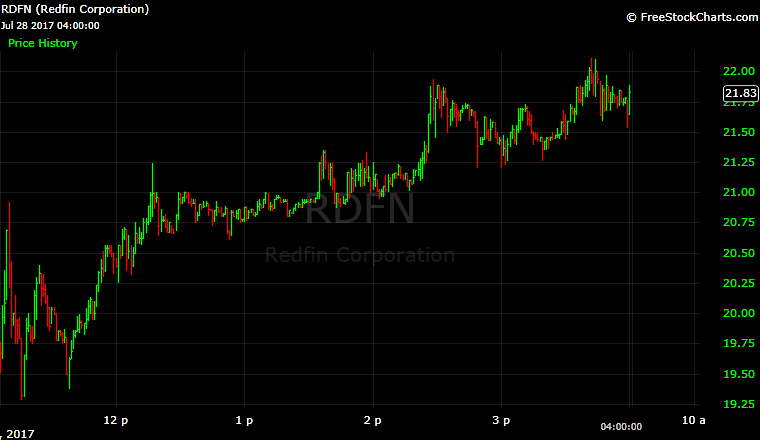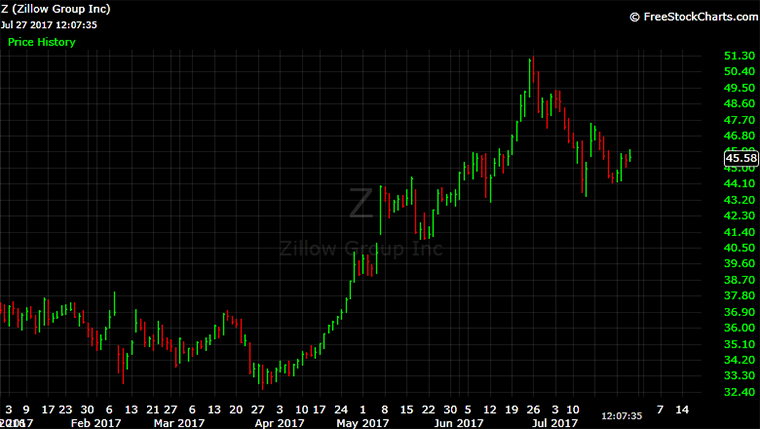
Getty
Online real estate company Redfin (RDFN) began trading Friday with a nice opening pop after the company raised more than expected Thursday night and closed sharply higher.
The stock closed at $21.70. That’s up nearly 45% from where it priced.
Here’s what you need to know about the Redfin IPO.
1. The IPO Raises $138.5 Million
Redfin sold 9.2 million shares at $15 pershare, above its expected range of $12 to $14. That raised $138.5 million.
The underwriters for the deal are Goldman Sachs, Allen & Co., BofA Merrill Lynch, RBC Capital Markets and Stifel.
The underwriters have the option to buy 1,384,650 additional shares.
Interestingly, the company said it has no definitive plans for what to do with the money.
“Accordingly, we will have broad discretion in using these proceeds, and investors will be relying on the judgment of our management regarding the application of the proceeds,” Redfin wrote in its S-1 SEC filing.
The company has raised nearly $168 million from 16 investors in 9 rounds of funding since 2005, according to Crunchbase.
2. Redfin Employs Its Own Real Estate Agents
Redfin is a multiple listing service (MLS) tech company. Through its website and app it connects prospective home buyers with its own team of real-estate agents.
The company uses “our own agents with our own technology to create a service that is faster, better, and costs less,” is said in the filing. “We meet customers through our listings-search website and mobile application, reducing the marketing costs that can keep fees high. We let homebuyers schedule home tours with a few taps of a mobile-phone button, so it’s easy to try our service.”
The company charges a commission to buyers of 1% to 1.5%, compared with the industry standard of 2.5% to 3%, it said.
With $1.5 trillion spend on middle-class homes last year from about 5.5 million transactions (according to the National Association of Retailers), Redfin estimates that $75 billion in commissions were paid in 2016.
The brokerage industry is by its nature fragmented.
“Our goal is to build the first large-scale brokerage that stands apart in consumers’ minds for delivering a unique and consistent customer experience, where the value is in our brokerage and its technologies, not just a personal relationship with one agent,” Redfin said.
The business model of Redfin is also highlighted in the prospectus as a potential pitfall – although to be fair all S-1 filings are duty bound to give potential investors as many risk factors as possible.
Redfin’s lead agents are employees, so that means benefits, expenses, training and other costs will impacts its bottom line.
3. Look to Monthly Average Visitors as Well as Revenue
The company is still not profitable, but its revenue is rising.
Revenue for 2016 to $267.2 million in 2016 from $1.87 million. Loss narrowed to $22.5 million from $30.2 million.
While the company says it strives “to be frugal” the main point will be how many visitors it can attract to its site.
Monthly average visitors rose to 16.2 million in 2016 from 11.7 million in 2015.
“The number of, and growth in, visitors to our website and mobile application are important leading indicators of our business activity because these channels are the primary ways we meet and serve customers,” Redfin said. We believe we can continue to increase monthly visitors, which allows us to grow.”
4. Co-Founder Threatens Litigation
While the financial disadvantage of having brokers as employees was noted above, and also the need to disclose in every S-1 any possible risk, there are few that stand out among the normal.
First, the company may be sued by co-founder David Eraker.
The letter asserts a variety of claims against us, Paul Goodrich, a director, and Madrona Venture Group, an investor, related to events prior to Mr. Eraker’s departure from Redfin in August 2006,” the company said it its latest filing. “Mr. Eraker released all claims against Redfin in connection with his departure. The letter focuses on allegations about the inventorship of one of Redfin’s patent applications that has not issued and does not cover our current products or services.”
The letter “threatens litigation” but there has not be a lawsuit filed.
Also, as a tech company, the company must continue to invest in its web and app presence.
“(C)hanges in mobile operating systems, such as Apple’s iOS and Google’s Android, that disproportionately affect us, degrade the functionality of our mobile website or mobile application, require that we make costly upgrades to our offerings, or give preferential treatment to competitive websites or mobile applications,” the company wrote.
Then there is the question of interest rates.
The Fed kept rates steady on Wednesday and it would start to unwind its balance sheet. But more importantly it said inflation was under control, below its 2% target, which could mean a further delay in hikes.
According to fed funds futures options, reported by the CME, the market sees no chance of a rate hike in September. In fact, it doesn’t see any rise until December and those odds are around 50%. The market predicts rates won’t rise next year above 2.25% from the current 1.25%.
Still, any gain in interest rates will impact borrowing for housing.
“Our business is sensitive to general economic conditions that are outside our control,” the company said. “These conditions include interest rates, inflation, fluctuations in consumer confidence, fluctuations in equity and debt capital markets, availability of credit, and the strength of financial institutions, which are sensitive to changes in the general macroeconomic environment.”
5. Is There Room for It With Much Larger Zillow?
The question after the strong pricing now becomes whether it follows Zillow (Z), which is up about 25% year to date.
Because of the two companies’ different structures, it looks like there should be room for both in the very fragmented real estate market.
Are you a thoughtful investor looking for uncommon investment ideas?
Stirling Strategic Investor is a new source of high-quality investment ideas from seasoned investment professionals Tim Collins and Kim Khan, formerly senior members of TheStreet.com. Tim and Kim share 50 insightful equity trade’s per year for $100. That’s just $2 per trade.
Tim and Kim’s first recommendation, Mobileye, was recently acquired at a 34% premium by Intel. We provide the first two ideas at Stirling Strategic Investor for free. We look forward to providing you uncommon ideas of true value.
Learn more at Stirling.


